

EN - ISED Innovation Lab 2016.pdf. Gov Innovation Labs Constellation 1.0. There’s no innovation agenda without design thinking. Sara Diamond is president and vice-chancellor of OCAD University.
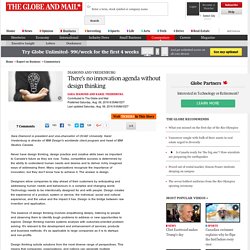
Karel Vredenburg is director of IBM Design’s worldwide client program and head of IBM Studios Canada. Never have design thinking, design practice and creative skills been as important to Canada’s future as they are now. What we do - Privy Council Office. The Hub is a resource for federal departments and agencies looking to adopt new and innovative approaches to solving complex policy, programming and service delivery challenges.

The Hub is a source of expertise and advice on emerging tools and technologies, such as behavioural economics, data analytics, design and social innovation, and is working to change the way the Public Service does business. The Central Innovation Hub provides three main services to federal public servants: The Hub acts as a resource for all departments and agencies. We provide information and guidance on new tools and techniques, such as behavioural economics, data analytics, design and social innovation. Through a variety of platforms including workshops and knowledge-sharing sessions, we share best practices and lessons learned from innovative projects at home and abroad so that departments can replicate what works. Innovation Labs in the public sector.
Adam Price and Bas Leurs from Nesta spoke about innovation labs and innovation culture within the public sector.

What is an innovation lab? “Innovation labs are ways of integrating cultures.They bring different perspectives together to create new ideas.” “Generating solutions to these big challenges we are facing.” “Creating a safe space to experiment.” Public sector innovation across Asia Pacific. Auckland Co-Design Lab. DesignGov as prototype of the future public service? We have discussed how DesignGov has been an ‘extreme user’ for the public service.
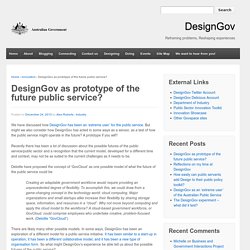
But might we also consider how DesignGov has acted in some ways as a sensor, as a test of how the public service might operate in the future? A prototype if you will? Recently there has been a lot of discussion about the possible futures of the public service/public sector and a recognition that the current model, developed for a different time and context, may not be as suited to the current challenges as it needs to be. Deloitte have proposed the concept of ‘GovCloud’ as one possible model of what the future of the public service could be: Creating an adaptable government workforce would require providing an unprecedented degree of flexibility. There are likely many other possible models. Small, flexible, cross-disciplinary team DesignGov was a small team, ranging from four people at its beginning to a maximum of ten at its peak, involving secondees from different agencies. World of Labs. Governments across the world are creating innovation teams and labs to help them find new ways of tackling the complex challenges of the 21st century.
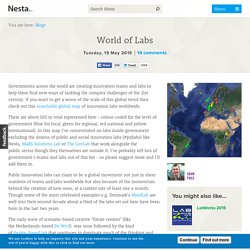
If you want to get a sense of the scale of this global trend then check out this searchable global map of innovation labs worldwide. There are about 100 in total represented here - colour-coded for the level of government (blue for local, green for regional, red national and yellow international). In this map I've concentrated on labs inside government excluding the dozens of public and social innovation labs (#psilabs) like Nesta, MaRS Solutions Lab or The GovLab that work alongside the public sector though they themselves are outside it. I've probably left lots of government i-teams and labs out of this list - so please suggest more and I'll add them in.
Despite the difference in focus, discipline and method, labs have at their core a shared belief in our capacity to prototype the future. Join us. UPDATE: Who's Coming to LabWorks? Global LabMap : Scribble Maps. OPSI - OPSI. » Behavioural Insights Team Australia. Our Sydney office plays a leading role in developing new behavioural approaches to public policy and service delivery across Australia and the Asia-Pacific.

Since 2012 we have partnered with the New South Wales’ Department of Premier and Cabinet (DPC) to establish a dedicated Behavioural Insights Unit that provides advice and strategic support to the New South Wales Government on public policy matters. This Unit has run successful behavioural trials and interventions across a number of different areas, including health systems, tax revenue, and return to work , and more recently domestic violence, social housing and obesity. Our reach now extends across Australia, and we have partnered with government and NGOs at the federal level, and in Victoria, New South Wales, Western Australia, Tasmania and South Australia. We focus on supporting organisations to identify, prioritise and scope behavioural interventions, as well as designing and delivering trials to evaluate their success. Team » Behavioural Insights. About. Mandate letter progress: Treasury Board Secretariat. January 11, 2016 The Honourable Kathleen Wynne Premier of Ontario Room 281, Main Legislative Building Queen's Park Toronto, Ontario M7A 1A1 Dear Premier: I welcome the opportunity to report to you on the commitments made in my mandate letter.
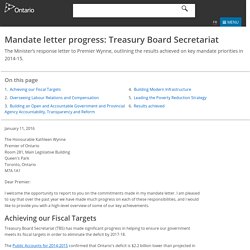
I am pleased to say that over the past year we have made much progress on each of these responsibilities, and I would like to provide you with a high-level overview of some of our key achievements. Achieving our Fiscal Targets Treasury Board Secretariat (TBS) has made significant progress in helping to ensure our government meets its fiscal targets in order to eliminate the deficit by 2017-18. The Public Accounts for 2014-2015 confirmed that Ontario's deficit is $2.2 billion lower than projected in the 2014 Budget and $0.6 billion lower than the interim projection in the 2015 Budget.
Through the PRRT process, the 2015 Budget identified a number of opportunities, including: Government of Ontario Announces New Behavioural Insights Unit. Last week was budget week for both the Ontario and federal public service.
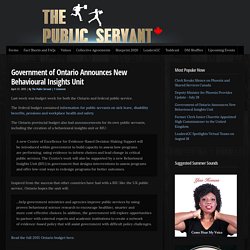
The federal budget contained information for public servants on sick leave, disability benefits, pensions and workplace health and safety. The Ontario provincial budget also had announcements for its own public servants, including the creation of a behavioural insights unit or BIU: A new Centre of Excellence for Evidence-Based Decision Making Support will be introduced within government to build capacity to assess how programs are performing, using evidence to inform choices and lead change in critical public services.
The Centre’s work will also be supported by a new Behavioural Insights Unit (BIU) in government that designs interventions to assess programs and offer low-cost ways to redesign programs for better outcomes. Inspired from the success that other countries have had with a BIU like the UK public service, Ontario hopes the unit will: Gov Innovation Labs Constellation 1.0. The landscape of public sector innovation labs. Interest in and awareness of the potential value of government innovation is on the rise, signalled, for instance, by it featuring as a central theme in the 2015 Government Summit, and in the creation of the OECD’s dedicated platform - The Observatory of Public Sector Innovation.
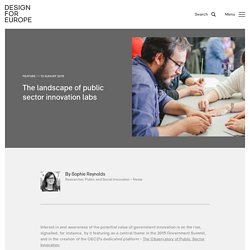
Government Innovators Network. Vision and Innovation Pathways. The Vision and Innovation Pathways below are the collective work of the Energy Futures Lab (EFL) Fellowship, drafted in a series of discussions over the past six months.
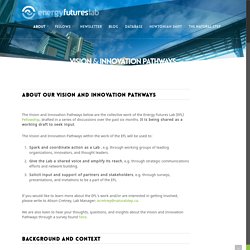
It is being shared as a working draft to seek input. The Vision and Innovation Pathways within the work of the EFL will be used to: Spark and coordinate action as a Lab , e.g. through working groups of leading organizations, innovators, and thought leaders.Give the Lab a shared voice and amplify its reach, e.g. through strategic communications efforts and network building.Solicit input and support of partners and stakeholders, e.g. through surveys, presentations, and invitations to be a part of the EFL. If you would like to learn more about the EFL’s work and/or are interested in getting involved, please write to Alison Cretney, Lab Manager: acretney@naturalstep.ca.
We are also keen to hear your thoughts, questions, and insights about the Vision and Innovation Pathways through a survey found here. Download the report. Nesta and Bloomberg Philanthropies have published the i-teams report to explore in-depth twenty innovation teams and funds from around the world. We analyse the diversity of structures and approaches, their impacts, and the key lessons for other government leaders looking to emulate these efforts. We present the new practices being developed and implemented by city and national governments around the world – to understand their different approaches, their successes and their limitations.
It acts a field guide for political leaders and executives who have the vision to innovate and need to create the capacity to make it happen. Key findings All governments need institutions to catalyse innovation. Based on our analysis i-teams fall into one of four categories: creating solutions to solve specific challenges, engaging citizens, non-profits and businesses to find new ideas, transforming the processes, skills and culture of government, or achieving wider policy and systems change. Gov Innovation Labs Constellation 1.0. Mapping Government Innovation Labs Around the World. Public servants can now locate other innovation labs at all levels of government around the world. Thanks to Nesta, a registered innovation charity in the UK that’s focused on helping, “people and organizations bring great ideas to life,” this searchable map has been colour coded with red pins to easily identify labs at the federal level, blue pins for the provincial/state level and green pins indicating the municipal level:
Innovation Across the Federal Government. Innovation Labs A Do It Yourself Guide. Mapping Government Innovation Labs Around the World. Global LabMap : Scribble Maps. Mapping Government Innovation Labs Around the World. World of Labs. Government’s new innovation ‘Hub’ open to new thinking. The federal government has opened its long-awaited “hub” of thinkers and policy wonks whose brainstorming could reshape the way policy is made and services are delivered in Canada.
The new Central Innovation Hub, which was promised in June 2013’s Blueprint 2020 roadmap to modernize Canada’s public service, officially opened Wednesday in a small office at 90 Sparks Street — a stone’s throw from its Privy Council Office mothership. The landscape of public sector innovation labs. Change%20Labs%20and%20Government%20in%20Canada. An Introduction to Government Innovation Labs - The Public Sector Digest. Mapping Public Innovation Places. Background There is a growing perception that the state’s ability to provide various forms of public service can be enhanced through public-private partnerships, the use of new technologies, as well as various strategies for increased public participation. Such new approaches to provide better services for individuals and communities require breaking the established routines and traditional structures of government, and rethinking the opposition between government bureaucracies and community actors. The good news is that new kinds of collaboration are emerging.
Such partnerships are characterized by horizontal practices such as co-governance, co-design, or co-production where citizens, experts, and governments work closely, together, to provide better public services. Innovation Labs: Bridging Think Tanks and Do Tanks. Over the past decade experimental policy and program design spaces have been emerging globally. Known as innovation labs, change labs or design labs, they are collaborative places where stakeholders with diverse perspectives engage in a workshop process to understand complex problems and design new approaches and solutions.
They provide the opportunity to develop prototypes designed and tested by participants from diverse perspectives before large investments are made. Gov Innovation Labs Constellation 1.0.